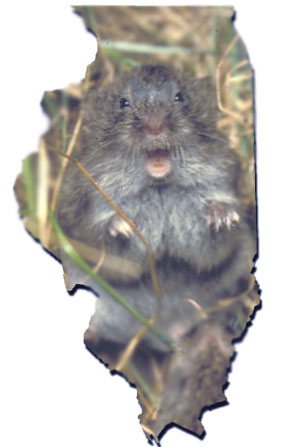
Long-term vole demographic data files
Lowell Getz - Department of Animal Biology - University of Illinois at Urbana Champaign - May 2004 - Vitae
Data files of
- 25 years of monthly live-trapping of Microtus ochrogaster and M. pennsylvanicus in alfafa, bluegrass, and tallgrass prairie;
- 63 months of twice-weekly 2-day live-trapping of M. ochrogaster in alfafa.
Explanation
There are two primary sets of long-term data files in this folder. One set includes data obtained for the prairie vole, Microtus ochrogaster, and the meadow vole, M. pennsylvanicus, in three habitats (alfalfa, bluegrass, and tallgrass prairie) by trapping at monthly intervals for 25 years. The other data are for the prairie vole, from a study in which the population was trapped twice weekly for 63 months. In addition, there are files giving monthly estimates of population density of the short-tailed shrew, Blarina brevicauda, for each of the three habitats.
I am placing these data at the disposal of anyone and everyone who might be able to make use of them. The only restriction on use of these data is that anyone planning on analyzing the data and publishing the results, should first attempt to contact Dr. Madan K. Oli, currently at (June 2004):
Department of Wildlife Ecology and Conservation
110 Newins-Ziegler Hall
University of Florida
Gainesville, FL 32611, USA
Dr. Oli also has the data files and has been given first rights on usage of the data. Anyone planning on using the data should, therefore, contact him to ensure there is no duplication of presentation. I and my colleagues have been publishing from the data sets. An up-dated bibliography is provided for your information.
I would appreciate being placed as a co-author on any papers for which these data serve as the primary data set. I realize this invokes a posthumous ego trip; however, if you do not place me as a co-author, do not expect any future research be successful and be prepared for any number of creaks and bumps in the night! If the data are only used as an example of another population fluctuation or otherwise constitute a minor part of the paper, a simple acknowledgement of the source of the data will suffice--no bumps in the night will ensue.
Lowell Getz
Demographic Study Trivia
Times of studies
Demographic study, Aug 1971-May 1997
Social behavior study, Mar 1981-May 1987
Trapping schedules:
Deomogaphic study (3 weeks each month, 25 years):
Sun 3 PM
Tue 3 PM
Wed, Thu, Fri 8 AM and 3 PM
Social behavior study (every week, 6 years):
Mon-Tue and Thu-Fri
0630
0930
1200
1530
2000
2230
0630
0930
Paid assistants: 49
Mouseketeers (unpaid undergrad volunteers; 30 hrs/semester—2 hr course credit): 1,063
Trips to study area: 11,300
Miles traveled to study area (@14 mi/trip): 158,200
Traps picked up and put down: 2,320,300
Animals handled: 236,700
My “structural recovery time” (time needed to get back in field--assistants covered missed time)
Hernia operation, 14 days
Rotator cuff surgery, 10 days
Cardiac artery angioplasty/steel stents, 4 days